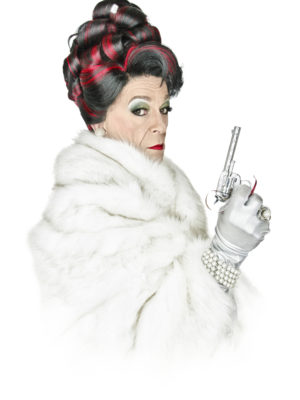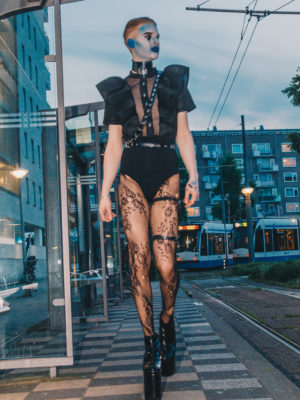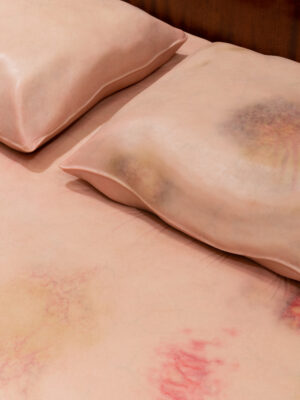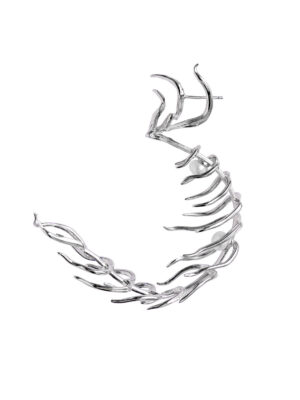Derrez and Hoogstede invited me to have a conversation about the exhibition Drag Power: Gender, Glamour, and Pride, which they co-curated with Roosmarij Deenik, a curator at the CODA Museum. The opening ceremony for Drag Power will take place on 14 November at the CODA Museum in Apeldoorn.
As the title of the exhibition suggests, Derrez and Hoogstede see drag as a powerful medium through which to talk about history, gender, personal stories, (in)justice and activism. I was curious to learn more about the content of the exhibition and what they thought about the political aspects of drag beyond its glamorous mainstream representation.
What the three of us have in common is that we all belong to the LGBTQI+ community, we all participate in the arts, and we all desire to critically interrogate heteronormative stereotypes. We are also all intrigued by drag as a political concept that permeates deeper than the surface of the body. What I don’t have is the experience that Derrez and Hoogstede share of having been alive and gay during the 1960s.
In our conversation, I quickly notice that we use different terms and attach different meanings to concepts related to gender and sexuality, and that certain words from within the LGBTQI+ scene are historically situated. Through the sharing of our different perspectives, I found that there was much I didn’t know about the drag practices and gay environments that existed before I was born. Derrez and Hoogstede made similar discoveries in their research for Drag Power. Given the infinite potential for self-expression offered by drag, there is always something new to learn.

Luca Soudant (LS)
What do you wish to communicate in the exhibition through the concept of drag?
Paul Derrez (PD)
The exhibition touches upon the history of drag, diversity in drag, its glamorous and theatrical side, but also its political, activist edges. When we started thinking about curating this exhibition, we thought: there’s a lot of attention to drag in the media, but it’s always quite superficial. Drag is usually very visual, and we wanted to dig deeper into the subject. There is a person beyond the glamour. So, we started with researching how drag manifested itself in history – for example, in theatre and in social life. In the exhibition, we tell this history in an international context and then move towards contemporary drag in a Dutch context.
Willem Hoogsteede (WH)
Did you know that there was a time in history when women were not allowed to perform? So, the roles of women had to be played by men.
PD
Indeed, this was in Greek times, in the Middle Ages, and in the 19th century. There are specific examples of drag from the 1920s: in cabaret and vaudeville. During the Second World War, drag was forbidden. When you talk about history, you also have to make clear what the differences are when you talk about ‘drag,’ ‘cross-dressing,’ or ‘transvestites.’ All relate to gender, but some practices are way more serious than others. People that crossdress once a year during Carnival, for instance, do this most likely with a different, less serious, mindset than theatrical drag performers. In Drag Power, we try to show the diverse attitudes and interesting histories of drag.
Through what mediums does the exhibition investigate drag as a concept? What kinds of works can we expect?
PD
Because drag is very visual, there is a lot of photography about it. There are contemporary photographers who focus predominantly on the concept of drag in their photography practice. For instance, one of the participating artists in the exhibition, Léon Hendrickx, made a series of photos called Kings and Queens in which he photographed drag queens and the ‘people behind’ the drag personas, without their costume. Then, he photoshopped these two ‘sides’ of the same person, so that they are embracing.
WH
In the exhibition, Hendrickx also shows a photo series in which he focuses on drag queens and their wigs. These are all wigs from John Gravemaker, a hairdresser who has specialised in the making of drag wigs.
I see all gender as drag, not just the extravagant ones, but also the genders that you and I are performing right now. Do you also address the performativity of day-to-day gender expression in the exhibition?
WH
Oh, yeah! Ru Paul once said: ‘Everybody was born naked and everything after that is drag.’ It’s true that a lot of how people dress is culturally designated.
PD
Yes, it’s very interesting that through making this exhibition, we learned a lot and noticed how the drag scene has changed over time. A while back, there were more traditional drag queens performing as Whitney Houston, Diana Ross and Tina Turner for instance. Today you also see more drag queens who ‘keep their beards’.
WH
Yes, and they show their naked flat chests while performing as women.
PD
This shows that there’s more diversity in today’s drag scene, less conforming to or exaggerating the stereotypical ‘feminine’ or ‘masculine’ features.

Do you address this contemporary move away from traditional drag in the exhibition?
PD
Yes. We chose five drag personas – four drag queens and one drag king – and interviewed them. This will be presented as five different films in Drag Power. We asked them what their motivation is for doing drag, what their practices entail, why they like it and how people around them reacted at first when they started. We also exhibit their drag clothes and accessories to make it complete. One of the drag personas, Chelsea Boy, is a drag queen or drag…
WH
…You can’t call him a drag queen, but he’s in drag.
PD
Yes, this drag persona is more futuristic. He’s inspired by comics. The way he dresses is like a futuristic alien. We have learned a lot from him and are very happy to include him, because he shows how, in today’s drag, people do not only choose between Whitney Houston, Diana Ross or Tina Turner.


So, do you mean that in the past, drag was more limited to stereotypes of the ‘feminine’ and ‘masculine,’ and nowadays there is more gender-bending happening in the drag scene?
PD
Indeed, today it seems that the motto is more ‘be as you want to be.’ Nowadays, everything is possible.
Next to Chelsea Boy, what other contemporary drag personas have you interviewed and documented for the exhibition?
PD
With the five people who were interviewed, there’s quite a diversity. Jennifer Hopeless, for example, is an activist and very important in a political sense.
WH
He is also the organiser of the Drag Olympics on the Westermarkt.
PD
We also interviewed Lady Galore, who is a real drag queen and very glamorous.
WH
He’s very much involved in getting people to do things together as a group of drag queens. He’s the person behind Drag Queens United.
PD
There is also an interview with drag king, Mason Tonight. She is very young, in her mid-20s – for us, that’s very young! She’s an example from very happy circumstances.
WH
She lives with her parents on a farm and they have, I think, 5,000 pigs. During the interview, her father came out of the pig shed to tell us about his daughter. Her parents are very supportive!
PD
And Licka Lolly…
WH
Yes, Licka Lolly! He is 28 and originally from Malaysia. That was a really wonderful interview. What he told us – such private, personal things – it was so moving!

Next to photographs by Léon Hendrickx and your own five-part video-interview project, what else can we expect at Drag Power: Gender, Glamour, and Pride?
PD
From the Groninger Museum we borrowed silkscreen prints by Andy Warhol, who made a series about New York queens – drag queens that is. He also made a series of reigning Queens with Beatrix and Elizabeth and so on. Next to that, we also curated pieces from the Amsterdam Museum. One of them is a painting about Hartjesdag [Dutch for ‘day-of-hearts’].
WH
Hartjesdag has a long history. It is a day at the end of August or in early September where women dress as men and men dress as women. Crossdressing was forbidden by the Germans during the Second World War and for a long time after the war it was still forbidden to be in public while cross-dressing in Amsterdam. This lasted up until 1983. It was even written in a police statement that you could be arrested for cross-dressing. Only on the 30th of April, on Hartjesdag, could people cross-dress. In the Amsterdam Museum, they have a painting about Hartjesdag, dating from the end of the nineteenth century.
There are also other borrowed pieces from the Amsterdam Museum present in Drag Power. For instance, Hellun Zelluf was a drag performer in the early 1980s who had a show on local television called The Gay Dating Show. When the AIDs epidemic came up he became an AIDs activist, and unfortunately died from AIDs later on. The Amsterdam Museum has outfits from him, and we will feature them in the exhibition.

Do you also speak about the violence towards drag performers?
WH
Yes. The exhibition will also include a project by Wouter van der Goor. You probably know that there is often violence against drag queens. Van der Goor approached several drag queens who had experienced trouble on the street. Together with them he went to the places where they were attacked and documented their experiences in photographs and wrote about each of them. Jennifer Hopeless, for example, was refused by multiple taxis and was very cross about it. Wouter went back with Jennifer Hopeless to the place where that happened – it was just here in Dam Square behind the palace.
PD
So, the exhibition also shows the negative sides of drag. It shows the other, less celebrated side. We should not accept that violence, we should stand up against it.

Can you tell me more about your history with gay rights activism?
PD
Well, we were not so radical.
WH
We were not really on the barricade, but when it was necessary we opened our mouths. Fifty years ago, we had both, separately from each other, had our coming out. During that period, most of the things people knew about being ‘gay’ were negative. And fifty years ago, in January 1969, there was the first…
PD
…Pride march. Well, it was not called a pride march. It was a demonstration.
WH
Indeed: a demonstration on the Binnenhof in the Hague. There was a law that said that someone over 21 could not have gay sex with someone between 16 and 21. However, heterosexuals could. The demonstration was against that unequal treatment.
PD
This was earlier on in the same year as the Stonewall Riots. It was a time in which people started to stand up for their rights. 1969 was a very important year for us in a political sense. It was a year that people stood up.
I see a lot of differences between your generation and mine. What makes me angry nowadays is the commercialisation of these protests – during Amsterdam Pride, for instance. There is an appropriation of activism for commercial profit. Having lived a longer life, how do you feel about that?
WH
Well, this year. The last Canal Pride in August…
PD
…Yeah, Amsterdam Pride was connected to Stonewall: ‘50 years after Stonewall!’ They tried to focus more on political and activist ideas but still – it’s a commercial parade.
WH
What was already better this year was that people couldn’t rent a spot along the canal and then play their own music and have their own party that was not related to what was happening on the water.
PD
So, they’re trying to regulate it in a positive way. Now that it’s become so big, it’s good in terms of visibility. When whole families come from the countryside to see the parade, it’s also good because when some of those children discover that they are gay, it might not be a problem anymore, because they have role models. Everything is commercialised these days; festivals which were alternative become commercial. It’s happening everywhere.
WH
But certain boats in the parades are from big companies. When they have a real, supportive policy for gay employees, I think it’s okay when they contribute. They have to pay much more money to take part, so in a way they support the whole thing. So, it’s a bit two-sided.
Were there ways of organising as gay rights activists beyond demonstrating when you were younger?
WH
Yes. In my practice as a teacher I was always open about being gay. Well, I didn’t enter the school and say, ‘Hey, I’m Willem and I’m gay’, but it was never a problem. I didn’t hide myself. In the early 80s in my teachers union, there was someone who asked for a gay teacher to join him, because he wanted to form a gay group within the union. So, I thought, ‘Yes, that’s it!’ I was a member of the first committee. I was the treasurer!
PD
Very important.
WH
Yeah, well, being on the committee was important. The highest board of the union took us very seriously and I was also in a committee with the chairman of the union. I did things!
PD
There were also gay student groups in every big city organising themselves.
I heard you collected buttons that were worn by gay rights activists in the late 70s, can you tell me more about that?
PD
In the second year after opening the Galerie Ra, we organised several exhibitions with themes. One was Jewellery With a Message, and for that we collected political buttons and badges and made an exhibition from them. We had different categories: nuclear weapons…
WH
…gay liberation…
PD
…and there were several environmental issues. So, we had eight chapters addressing different topics. That exhibition travelled to several places and recently we showed some of it in Munich and in the Amsterdam Museum.
Since you are artists, gallery owners and collectors, how do you see the role of art, or specifically of jewellery, in conveying political messages?
PD
I think it’s very hard to combine jewellery with a political message. I mean, a button is not art jewellery. It’s just a button. A button is the most simple and clear way to show a social or political message, but when it becomes more complicated it becomes more diffuse. But sometimes you can express a message in jewellery. [Willem opens De Geschiedenis van Nederland in 100 Voorwerpen to an image of one of Paul’s phallic necklaces]
WH
This book is The History of the Netherlands in 100 Items, and in chapter 98 there is a symbolic necklace called Face that was made by Paul (1994). The book says: ‘It’s a sign of the emancipation of homosexuals.’
PD
Ha, he’s my agent. This piece is not like a button with a text, but it’s an indirect kind of comment on gender roles. I was often asked by the organisers of fashion shows whether I could make ‘jewellery for men.’ I was very cross about this and so I said, ‘What do they mean, jewellery for men?’ I always had thought that I would make and show jewellery and that everybody could wear it. So, as a response to this question I made a collection of this type of jewellery, which has sexual content but also a kind of hardware- weapon-type content. Of course, I made it for myself, but then I thought, ‘What audience did I make it for?’ Some gay people bought it, but also people like Marjan Unger, a Dutch art historian – she bought it and wore it on a train and got many different responses. So, what I am trying to get at is that jewellery becomes interactive because it’s asking for reactions. In that way, jewellery is not so strict. It’s quite open. A piece of jewellery is a conversation piece. A piece of jewellery conveys a different message depending on the person wearing it and the situation around it. It can be the same piece but the circumstances will change it completely. We like to play with jewellery and experience the responses to it and start conversations with people about stereotypes.

This article is published in the OBSESSED! Jewellery Festival Paper.
OBSESSED! is a biennial jewellery festival taking place in various cities across the Netherlands. OBSESSED! unites the best jewellery-related events – museum and gallery exhibitions, talks, fairs, book presentations and artist open studios – into one intriguing programme put together by Current Obsession.
Drag Power
Date 03–11–2019 until 01–03–2020
Opening 14 November 21 Grams Date 13–10–2019 until 02–02–2020
Handshake 5 Date 13–10–2019 until 02–02–2020
Location CODA Museum Vosselmanstraat 299 7311 CL, Apeldoorn
Website www.coda-apeldoorn.nl
The museum is closed on: 25 December, 1 January and 27 April



